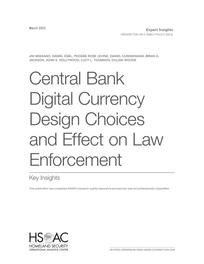Central Bank Digital Currency Design Choices and Effect on Law Enforcement
Key Insights
Expert InsightsPublished Apr 16, 2025
Key Insights
Expert InsightsPublished Apr 16, 2025

The Federal Reserve's exploration of a U.S. Central Bank Digital Currency (CBDC) raises questions about such a currency's effect on U.S. law enforcement's ability to detect and investigate crime. The authors of this paper identify key CBDC design choices that could affect law enforcement capabilities. They underscore the need to evolve investigative techniques to meet relevant challenges if a U.S. CBDC is launched.
This work was commissioned by U.S. Department of Homeland Security (DHS) Science and Technology Directorate and was conducted in the Infrastructure, Immigration, and Security Operations Program of the RAND Homeland Security Research Division (HSRD).
This publication is part of the RAND expert insights series. The expert insights series presents perspectives on timely policy issues.
RAND is a nonprofit institution that helps improve policy and decisionmaking through research and analysis. RAND's publications do not necessarily reflect the opinions of its research clients and sponsors.